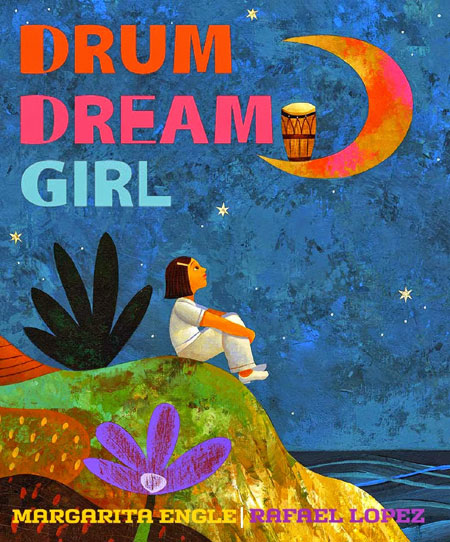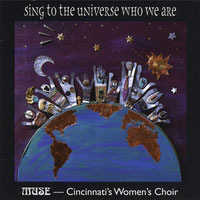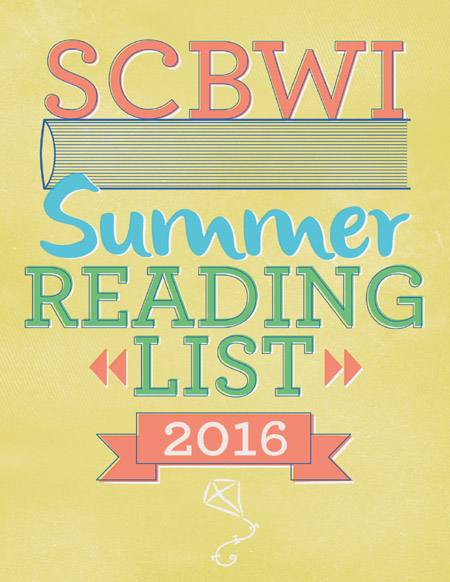Last November, I received a packet from Barbara Krol-Sinclair with a cover-letter from Chelsea Public Schools, Intergenerational Literacy Program (ILP). Included in the packet was a letter from Barbara, Director (on behalf of the teachers, tutors, and families of ILP), a small spiral-bound collection of writings by ILP families, and a collection of letters to me from parents about five of my books.
What joy it was to sit and read the letters about which of my books (The Rainbow Tulip, I Pledge Allegiance, Tomás and the Library Lady, Book Fiesta or Water Rolls, Water Rises) was their favorite. Talk about the way to a writer’s heart!
Much as I enjoy the letters, what has also amazed me is the ILP concept, its philosophy, tenets, structure.
I want to assist in sharing this important and successful model. Barbara and her colleague Jeanne Paratore agreed to answer some questions.
1. First, please introduce yourselves and this work.
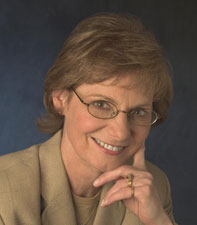
Jeanne Paratore
My name is Jeanne Paratore. I began this work in 1987 as a response to evidence that families living in poverty typically have little access to the educational experiences and resources that we know make a difference in learning success–for both parents and children. As I worked with many others to design the program, there were a few principles that we were strongly committed to and became “non-negotiable” as we put the pieces together.
One was to position parents as models of strength–to recognize that whatever their educational backgrounds and experiences, the parents we hoped to attract to this program brought with them rich knowledge and experiences—labeled by educator and researcher Luis Moll as “funds of knowledge”–that, if uncovered and celebrated–would serve their children well. In concert with this, we were also committed to position the literacy and language learning that we intended to provide within a context of authentic and valuable experiences woven within and throughout the fabric of everyday life. We did NOT want to provide a school or library-based story hour once or twice a week or any sort of a “packaged” curriculum.
Rather, we wanted parents and young children to sing and recite nursery rhymes and favorite songs throughout the routines of their day–as they bathed, dressed, cooked, and played. We wanted parents and older children, too, to read, write, and talk together as they went about their daily tasks, using their first language and English to learn more about their world and that parents, themselves, had their own needs. That is, we wanted to acknowledge that even as parents joined us largely because they wanted to help their children succeed in their new country, they were most likely to stay with us if we were meeting their adult needs also–so we deliberately designed a program that would set aside time for parents to read, discuss, and write about topics of interest and importance to adults–how to find a job; find housing; become a citizen; keep their children safe in a new community.
That’s how our work started, and now 27 years later, we are proud to say that those same principles continue to guide our work.
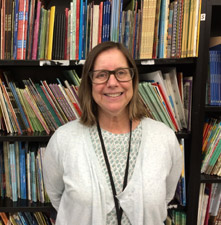
Barbara Krol-Sinclair
My name is Barbara Krol-Sinclair. I came to the ILP midway through its second year when I entered doctoral studies at Boston University School of Education, thinking that it would be a small step on my educational journey. Jeanne’s vision and how it plays out in ILP classes completely changed the trajectory of my life, and I have now been here for more than 25 years, 21 of them as the director.
The program has grown and changed in its scope over time—more types of classes, more hours, more people. The core mission of supporting parents to strengthen literacy so that they can move forward in their own lives and help their children succeed in school and live, however, is still at the forefront of what we do. We offer ongoing instruction that is rooted in the lives and interests of the families we serve, that builds on parents’ knowledge and strengths, and that is purposeful and based on what research tells us is best practice. That’s how we found our way to you: our family literacy classes focused on your books in an author study unit, which supported parents’ knowledge of children’s stories with which they can connect.
2. I am simply amazed by the creative and important work you are doing and want to share your concepts and strategies. Since this is a creativity salon, let me begin by asking if you think of yourselves as creative? And this work?
Jeanne: Well, in truth, I don’t think we think of ourselves as creative–in fact, I think just the opposite. I think we are working with a fundamentally common-sense model–that is, we begin with genuine respect for the families we hope to recruit; and with a belief and an expectation that we had as much to learn from them as we can teach to them. And we can accomplish it all by situating the literacies we hope they will make part of their daily routine within important family, community, and school routines.
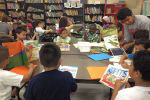
Barbara: I think that our work is less about creativity and more about responsiveness. Two key phrases that seem to guide our daily work are: “Vamos a ver” and “Flexibility is a virtue.” Sometimes one of us will come up with an innovative idea (which may or may not work), but it derives from the families themselves. For example, we tried out a parent-child book discussion group last summer, based on parents’ interest in knowing more about what their children are reading; we’ll tweak it for this summer.
3. Briefly describe your program: how it began and where you are now.
Jeanne and Barbara: The Intergenerational Literacy Program (ILP) was begun in 1989 in Chelsea, MA by Dr. Jeanne R. Paratore, Professor of Education at Boston University. The program was developed to achieve three goals:
- Improve the English literacy of parents.
- Support the literacy development and academic success of their children.
- Conduct research on the effectiveness of an intergenerational approach to literacy.
To accomplish these goals, the ILP offers literacy instruction in English to parents of preschool- and school-aged children. As parents share reading and writing with their children, parents will support their own literacy learning through practice and application. Instruction for parents is designed to achieve a two-fold purpose: (1) to provide parents an opportunity to read and respond to materials of adult interest; and (2) to provide a selection of books, strategies, and ideas for use with their children.
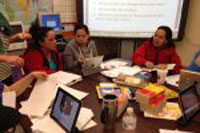
Since its inception, the ILP has served over 2500 families. These families have come from 70 different countries and spoken 40 different first languages. Studies of the children of ILP learners have found that they tend to perform better academically than their non-ILP peers. Pre-K and kindergarten children of ILP learners have shown substantially greater gains in early literacy growth and vocabulary knowledge than non-ILP children. Significantly more ILP first graders achieved on or above grade level than non-ILP first graders. Longitudinal studies of ILP children also demonstrated continued high academic achievement. Children who were studied 10 years after their parents participated in ILP showed higher attendance rates, higher promotion rates, and higher high school graduation rates that their non-ILP peers.
Participation in the ILP has long-lasting positive effects on the academic performance of children, but it also helps adult learners achieve their personal goals.
4. What are a couple of your major challenges? Major joys? Major dreams?
Jeanne: During our first few days, weeks, and months our major challenge was gaining trust in the community–despite blanketing the community with all sorts of information about the new program, on the first day we enrolled only two families. But we didn’t give up–we continued to visit neighborhood agencies, shops, churches, schools——and in time we grew, from 2 to 16, from 16 to 40, from 40 to 60, and now to more than 200 families and adult learners each and every week of the academic year.
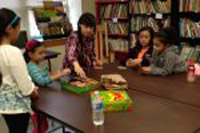 So now our challenge is different–finding sufficient funding to keep going; making certain we maintain the highest instructional standards and this means keeping our eye of the ball–recognizing that the families who join us have many, many critical needs–but the only ones we are qualified to effectively meet are those that have to do with literacy and language needs. All the others–housing, employment, personal safety and so much more–we must turn to community agencies for. Maintaining those kinds of boundaries–making sure we are positioned to find resources but recognizing that we must stay focused on our mission–on what we are most knowledgeable about–demands constant vigilance.
So now our challenge is different–finding sufficient funding to keep going; making certain we maintain the highest instructional standards and this means keeping our eye of the ball–recognizing that the families who join us have many, many critical needs–but the only ones we are qualified to effectively meet are those that have to do with literacy and language needs. All the others–housing, employment, personal safety and so much more–we must turn to community agencies for. Maintaining those kinds of boundaries–making sure we are positioned to find resources but recognizing that we must stay focused on our mission–on what we are most knowledgeable about–demands constant vigilance.
Our biggest joy is seeing–day in and day out, year in and year out–the success this sort of community learning can bring. Moms, dads, grandmothers, grandfathers, uncles, aunts, children from all ages–walking across the stage each May clutching each other’s hands, receiving with so much pride their certificates, celebrating their accomplishment with family and community–there is little doubt that that is the biggest joy.
And our biggest dream is that some day, this sort of educational experience will be taken for granted–it won’t require a generous private donor or, more accurately, a large collection of donors–rather, it will be built into the fabric of public education and made available to every family. And when it is, some of the tragedy and sadness that we see around us will be less–that education will, indeed, be the pathway to a more equitable and just world. Maybe a dream too big–but it is, nonetheless, ours.
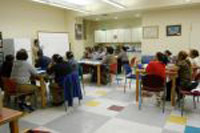 Barbara: The joys are many. On average, parents in our program have attended school for 8 years, and about 15% have 2 or fewer years of school, and most speak little English. When I began teaching at the ILP, seeing literacy growth and change in parents seemed so incremental on a daily basis that it was hard to imagine the major life changes that they were seeking. Now, though, I have the great advantage of viewing families’ lives longitudinally: the little children who grew up to attend great colleges and are now dedicated parents; and the former learners in the program who have become early childhood teachers, school paraprofessionals, and even ILP teachers.
Barbara: The joys are many. On average, parents in our program have attended school for 8 years, and about 15% have 2 or fewer years of school, and most speak little English. When I began teaching at the ILP, seeing literacy growth and change in parents seemed so incremental on a daily basis that it was hard to imagine the major life changes that they were seeking. Now, though, I have the great advantage of viewing families’ lives longitudinally: the little children who grew up to attend great colleges and are now dedicated parents; and the former learners in the program who have become early childhood teachers, school paraprofessionals, and even ILP teachers.
The greatest challenge on a daily basis is expansion: we would love to have ILP programs all over, but, as Jeanne notes, to incorporate this program across the US (and the world?) requires a shift in how families’ contributions to their children’s learning are valued.
5. How can interested literacy advocates learn more about your program and how to create their own?
Jeanne and Barbara: We have a website through Boston University and another through the Chelsea Public Schools.
We have written many articles, chapters, and a couple of books that feature the ILP, as well as a brand new replication manual. If you’re interested in learning more, email Barbara.
6. Personally, what is bookjoy for each of you? What do you like to read and/or what are you reading now?
Jeanne: At this moment, I am just beginning the Elena Ferrante Neapolitan series–I bought the collection for my daughter for Christmas and she loved it–has made me promise I will return them to her when I finish. I’ve read only the beginning pages of the first in the collection– these will keep me going for a bit.
And I have 3 wonderful grandsons–one brand new–and so we are also immersed in all sorts of children’s books–our little 4-month-old Lucas is especially fond of nursery rhymes and Tomie DePaola’s versions call to us very often! And our 7 and 9 year olds both love graphic novels–admittedly not my strong suit but I’m learning to love them!
And one more thing–of course Pat Mora’s books are “go-to’s” but one is a particular favorite–The Desert is My Mother–we love the words and images–we love the affection that flows from the text–and we love the opportunity to experience all of this bilingually.
Barbara: Right now, my ‘grown-up’ book is A Little Life by Hanya Yanagihara: I tend to gravitate to novels that center on relationships.
I am always reading a host of children’s books and young adult novels, too. We are constantly trying to build up the ILP library and bring in as many books that reflect our families’ experiences as we can. Most recently, that has led us to seek out books that include immigration stories, urban life, change, growth, and learning. My new favorite chapter books are The Red Pencil by Andrea Davis Pinkney, Brown Girl Dreaming by Jacqueline Woodson, Caminar by Skila Brown, and Inside Out and Back Again by Thanha Lai. I love the beautiful graphic novel El Deafo by Cece Bell. My new favorite picture books are Dear Primo by Duncan Tonatiuh, Four Feet, Two Sandals by Karen Williams, and I Don’t Want to Be a Frog by Dev Petty. And SO many Pat Mora books–my favorite is Tomás and the Library Lady/Tomás y la señora de la biblioteca.
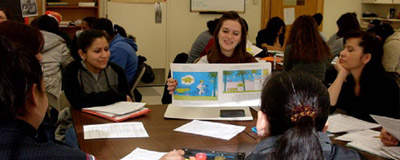
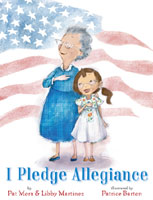 What fun my daughter Libby Martinez and I had working on PLEDGE. Writing a book is always a challenge, and we were writing about a wonderful lady in our lives, my aunt and Libby’s great aunt, Ygnacia Delgado. Like many, she and her father and sisters came to this country long ago hoping for a better life. She called us her “lobitos,” her little wolves, and we all called her Lobo.
What fun my daughter Libby Martinez and I had working on PLEDGE. Writing a book is always a challenge, and we were writing about a wonderful lady in our lives, my aunt and Libby’s great aunt, Ygnacia Delgado. Like many, she and her father and sisters came to this country long ago hoping for a better life. She called us her “lobitos,” her little wolves, and we all called her Lobo.





 So now our challenge is different–finding sufficient funding to keep going; making certain we maintain the highest instructional standards and this means keeping our eye of the ball–recognizing that the families who join us have many, many critical needs–but the only ones we are qualified to effectively meet are those that have to do with literacy and language needs. All the others–housing, employment, personal safety and so much more–we must turn to community agencies for. Maintaining those kinds of boundaries–making sure we are positioned to find resources but recognizing that we must stay focused on our mission–on what we are most knowledgeable about–demands constant vigilance.
So now our challenge is different–finding sufficient funding to keep going; making certain we maintain the highest instructional standards and this means keeping our eye of the ball–recognizing that the families who join us have many, many critical needs–but the only ones we are qualified to effectively meet are those that have to do with literacy and language needs. All the others–housing, employment, personal safety and so much more–we must turn to community agencies for. Maintaining those kinds of boundaries–making sure we are positioned to find resources but recognizing that we must stay focused on our mission–on what we are most knowledgeable about–demands constant vigilance. Barbara: The joys are many. On average, parents in our program have attended school for 8 years, and about 15% have 2 or fewer years of school, and most speak little English. When I began teaching at the ILP, seeing literacy growth and change in parents seemed so incremental on a daily basis that it was hard to imagine the major life changes that they were seeking. Now, though, I have the great advantage of viewing families’ lives longitudinally: the little children who grew up to attend great colleges and are now dedicated parents; and the former learners in the program who have become early childhood teachers, school paraprofessionals, and even ILP teachers.
Barbara: The joys are many. On average, parents in our program have attended school for 8 years, and about 15% have 2 or fewer years of school, and most speak little English. When I began teaching at the ILP, seeing literacy growth and change in parents seemed so incremental on a daily basis that it was hard to imagine the major life changes that they were seeking. Now, though, I have the great advantage of viewing families’ lives longitudinally: the little children who grew up to attend great colleges and are now dedicated parents; and the former learners in the program who have become early childhood teachers, school paraprofessionals, and even ILP teachers. 
